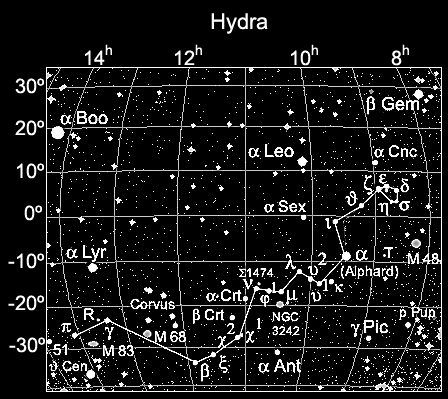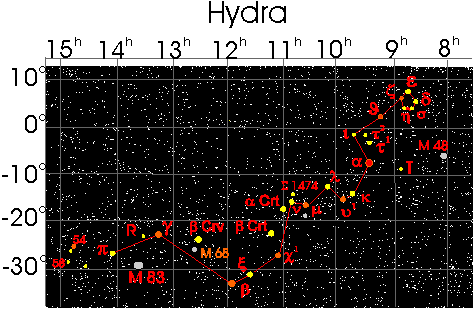
Hydra is the largest constellation of all, but also one of the least known since so many of its stars are 4th- and 5th-magnitude or fainter. Also, while Hydra contains a number of Messier objects and other DSOs, none could be considered ‘exceptional’. There are, however, several very fine binaries and some notable variables. And --like Eridanus-- just being able to follow its stars across a great swath of sky can be considered a fine accomplishment.
The Hydra makes its first appearance late in Winter, and over the next few months slowly slithers across the skies earlier and earlier. The most logical way to begin investigating Hydra is to start at the Hydra's Head, the tight asterism just south of Cancer. If you aren't sure you can find the Hydra's Head, first locate Procyon and draw a line over to Regulus. Follow this line across the skies with binoculars, and you'll find the Hydra's Head just before you pass the mid-point. Alternatively, you can begin at the Hydra's heart, alpha Hydrae. This bright star forms a triangle with Procyon and Regulus.

Alpha Hydrae is called Alphard (Solitary One) short for Al Phard al Shuja, "The Solitary One in the Serpent", although it has a number of neighbours. From its position and brightness Alphard serves as the serpent's heart and was aptly so named by Tycho Brahe: Cor Hydrae, a name which nevertheless didn't stick. The snake's body stretches out to the southeast, below Leo. From Alphard to the south-southeast, just outside the viewing area of Alphard, is upsilon-1, at which point the snake's body curls upward, toward the northeast.
Beta Hydrae, in the same FOV of xi Hydrae isn't, as one might think, the second brightest star in Hydra. It's only a 4.6 visual magnitude, with a 5.6 companion, which is even fainter than xi Hydrae. Beta Hydrae marks the southern-most point of the Hydra's body and at a declination of almost -34º it won't be visible for much of North America. Two constellations are found in the 'pocket' formed by this long southern loop of the serpent -- Crater and Corvus. The more useful of these, as we procede along the serpent's back, is Corvus, The Crow.
At beta Hydrae draw a line over to Spica, alpha Virgo, which is to the northeast. Nearly half-way along this line you'll cross the bright star beta Corvi. In the same field as beta Corvi is the Messier object, M68, a globular cluster containing over a hundred thousand stars. With beta Crt at the top of your FOV, you'll see two 5th-mag stars just off centre. The brighter of these, to the west, is Chi1 Hydrae, which is a 5th-magnitude binary with a similar companion. with a very rapid orbit. This companion makes a complete revolution every 7.4 years, which means that the separation is never more than 0.1". Now placing chi1at the northwest corner of your FOV, xi Hydrae will be just out of view to the southeast. Sweep slowly to the southeast and put this star at the upper right of your FOV. Beta Hydrae will also now be visible, to the southeast.
Gamma Hydrae is most easily found by beginning at Spica. Twelve degrees due south of this very bright star is gamma Hydrae, the last 'hump' or coil in the serpent Hydra. Gamma Hya is also due east of beta Corvi, if you found this star while searching for M68.
Gamma Hya has an interesting neighbour, R Hydrae, a Mira-like long-period variable. R Hya has a period of 389 days, when it rises from a faint 10 visual magnitude to a rather bright 3.5 or so. You've nearly reached the end of the serpent's tail, which is marked by pi Hydrae. Sweeping your glasses two full FOVs southeast of gamma Hydrae brings you to pi Hydrae.
While this may be the end of the serpent's tail (some extend the tip to include 58 Hya), there's more here to investigate involving 54 Hya.
The region around mu Hydrae has several interesting objects. To the east, in the same FOV, is the brighter star nu Hydrae. Just to the northwest of this star is the fine binary Struve 1474, a fine triple of 7th mag stars. There is a neighbouring binary of 8th mag stars, Struve 1473, just to the south half a degree. Two degrees south of mu Hydrae (same FOV of this star) is the deep sky object NGC 3242, a 9th mag planetary nebula sometimes called "The Ghost of Jupiter". Medium sized telescopes show a round greenish object. Now moving over to nu Hydrae, you'll see a much brighter star to the southeast. This is alpha Crateris. Nu Hydrae is in fact nearly on the border with Crater. It's more convenient at this point to hop briefly into Crater to continue your descent down the Hydra's back. Placing alpha Crateris at the northern edge of your glasses, you'll see a similarly bright star to the southeast, beta Crateris.
Theta Hydrae is the mid-point along the Hydra's neck. It's a 3.9 visual magnitude star with an optical companion. Putting theta Hydrae at the northwest corner, you'll see tau-1 and tau-2 with a subtle colour contrast, cream-white and pale blue. The bright star just out of the FOV to the southeast is iota Hydrae; this star has a soft red colour to it. Tau-1 (4.6) has a wide 7th-mag companion, about 66" away. If you place tau-1 at the top of your FOV, alpha Hydrae comes into view.
Upsilon1 Hydrae marks one of the 'coils' of Hydra, and the snake curls toward the northeast. The star the farthest east in this FOV, lambda Hydra, marks about a third of the way down the Hydra's outstretched form. It's due south from Regulus and is a convenient point if you wish to study the constellation lying between Hydra and Leo at this point, which is Sextans. Alpha Sextantis is most easily found by drawing a line between Regulus and lambda Hya; it lies almost exactly at the midpoint on this line. Now place lambda at the northwest corner of your FOV. Mu Hydrae will appear at the far opposite corner.
Zeta Hydrae is an orange giant (7-10 times the size of the Sun) which forms the top of the neck of the Hydra, and is the brightest star in the asterism known as The Hydra's Head. From amongst this group of stars epsilon Hydrae is the most remarkable, as it is a splendid multiple binary. Companion B is much too close for all but the largest of telescopes, for it has a very rapid orbit of 15.06 years. More accessible for medium and large telescopes is companion C, which forms a pleasing contrast of colours with the primary -- yellow and blue. The orbit is 990 years. Putting zeta at the northwest edge, omega and theta are now visible, and you can proceed to examine the rest of the Hydra.
